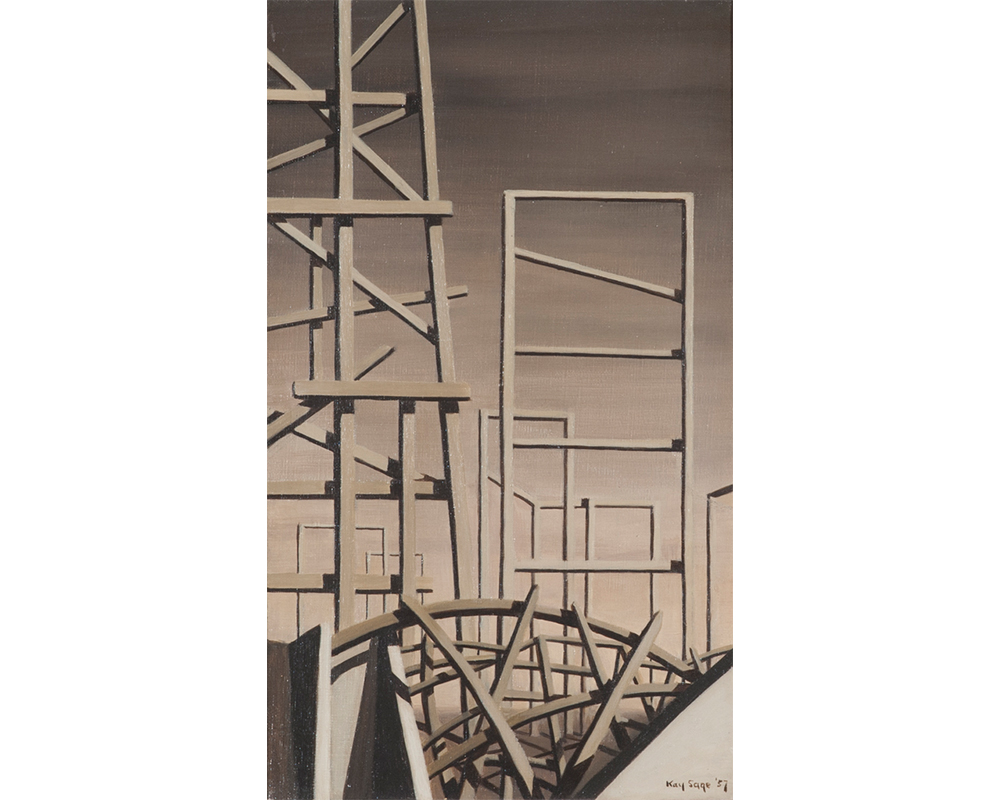
Your Move: Kay Sage's Surrealist Assemblages
Guest blogger Renee Klann '19 is a Smith College student, class of 2019. She was the 2015-2017 STRIDE scholar in the Cunningham Center for Prints, Drawings, and Photographs.
Kay Sage was an American Surrealist artist. After growing up in both the U.S. and Italy, she moved to France and met the Surrealists. Their movement, which drew on dreams and the subconscious, inspired Sage. In the late 1930s and early 1940s she developed a personal Surrealist style based on mysterious architectural forms in somber-colored settings. Although the forms are painted realistically, they convey an impression or feeling rather than actual objects.

Sage, Kay. American, 1898–1963. Cooling the Stars, 1957. Oil on canvas. Promised gift from a Private Collection, Houston. SC TR 7808.4.
In the late 1950s Sage developed cataracts, which made her eyesight too poor to paint. Rather than giving up on making art, Sage created assemblages and wrote poetry. In a letter to Marcel Duhamel, she said “I’ll have a show . . . of objects I’ve managed to make to replace paintings.” Her 17 small three-dimensional objects were shown at the Catherine Viviano gallery in November 1961.
Sage almost never explained the meaning of her work, and the assemblages were no exception to this rule. The only clues to their meaning are their titles and the lines of Sage’s poem “Your Move” that they were paired with.
Your Move
These are games without issue
some have been played
and are therefore static
others will be
and can still be played
there are no rules
no one can win or lose
they are arbitrary
and irrelevant
but there is no reason why
anything should mean more
than its own statement
two and two
do not necessarily make four
If that is a scientist at my door
please tell him
to go away
The lines “there is no reason why / anything should mean more / than its own statement” reflect Sage’s reluctance to offer explanations of her work. For her, a painting or assemblage spoke for itself, and she did not want to put precise meanings on her dreamlike images. The poem also suggests that Sage was probably influenced by Surrealist games such as Exquisite Corpse, in which each player added part of a drawing or a sentence without seeing the other players’ contributions to create an unexpected final product.
Some of the assemblages included in the exhibition were Sourir D’hiver (Winter Smile), a piece of crinkled foil mounted in a wood frame with a magnifying glass; Your Move, which resembles a chess board with bullet cartridges instead of chess pieces; and Nuclear Tension, made of a spring and a ball bearing inside a glass tube.

Sage, Kay. American, 1898–1963. Tides Will Be High From Now On, 1961. 98 blue and clear glass beads, wood box with four stones, four convex lenses on wood ground. Promised gift from a Private Collection, Houston. SC TR 7808.5.
Tides Will Be High From Now On combines ninety-eight blue and clear glass beads with four stones resting on glass lenses, all in a wood box. The corresponding line of the poem is “there are no rules.” This piece can be seen as a game without rules because the beads are free to move in unpredictable patterns in response to a ‘player’s’ movements.
The show Your Move was Sage’s last before she committed suicide in 1963. The objects she made in her final years demonstrate how even in the face of obstacles, Sage continued to make art that was true to her Surrealist vision.